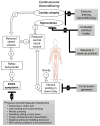Exercise and non-pharmacological treatment of POTS
- PMID: 30001836
- PMCID: PMC6289756
- DOI: 10.1016/j.autneu.2018.07.001
Exercise and non-pharmacological treatment of POTS
Abstract
Recent research has demonstrated that cardiovascular deconditioning (i.e., cardiac atrophy and hypovolemia) contributes significantly to the Postural Orthostatic Tachycardia Syndrome (POTS) and its functional disability. Therefore, physical reconditioning with exercise training and volume expansion via increased salt and fluid intake should be initiated early in the course of treatment for patients with POTS if possible. The use of horizontal exercise (e.g., rowing, swimming, recumbent bike, etc.) at the beginning is a critical strategy, allowing patients to exercise while avoiding the upright posture that elicits their POTS symptoms. As patients become increasingly fit, the duration and intensity of exercise should be progressively increased, and upright exercise can be gradually added as tolerated. Supervised training is preferable to maximize functional capacity. Other non-pharmacological interventions, which include: 1) chronic volume expansion via sleeping in the head-up position; 2) reduction in venous pooling during orthostasis by lower body compression garments extending at least to the xiphoid or with an abdominal binder; and 3) physical countermeasure maneuvers, such as squeezing a rubber ball, leg crossing, muscle pumping, squatting, negative-pressure breathing, etc., may also be effective in preventing orthostatic intolerance and managing acute clinical symptoms in POTS patients. However, randomized clinical trials are needed to evaluate the efficacies of these non-pharmacological treatments of POTS.
Keywords: Deconditioning; Exercise intolerance; Physical activity; Physical countermeasures; Venous pooling; Volume expansion.
Copyright © 2018 Elsevier B.V. All rights reserved.
Conflict of interest statement
The authors declare that the research was conducted in the absence of any commercial or financial relationships that could be constructed as a potential conflict of interest.
Figures
References
-
- Bruce BK, Harrison TE, Bee SM, Luedtke CA, Porter CJ, Fischer PR, Hayes SE, Allman DA, Ale CM, Weiss KE. Improvement in Functioning and Psychological Distress in Adolescents With Postural Orthostatic Tachycardia Syndrome Following Interdisciplinary Treatment. Clin Pediatr (Phila) 2016;55(14):1300–1304. - PubMed
-
- Claydon VE, Hainsworth R. Increased postural sway in control subjects with poor orthostatic tolerance. J Am Coll Cardiol. 2005;46(7):1309–1313. - PubMed
-
- Convertino VA, Cooke WH, Lurie KG. Inspiratory resistance as a potential treatment for orthostatic intolerance and hemorrhagic shock. Aviat Space Environ Med. 2005a;76(4):319–325. - PubMed
Publication types
MeSH terms
Grants and funding
LinkOut - more resources
Full Text Sources
Other Literature Sources
Medical
Research Materials


